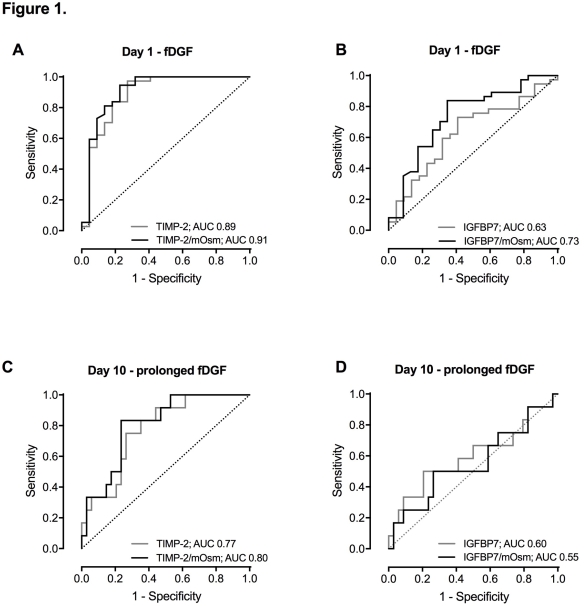Urinary TIMP-2 Predicts the Presence and Duration of Delayed Graft Function in DCD Kidney Transplant Recipients
1Nephrology, Leiden University Medical Center, Leiden, Netherlands
2Clinical Chemistry and Laboratory Medicine, Leiden University Medical Center, Leiden, Netherlands.
Meeting: 2018 American Transplant Congress
Abstract number: A52
Keywords: Cadaveric organs, Kidney transplantation, Monitoring, Urinalysis
Session Information
Session Name: Poster Session A: Biomarkers, Immune Monitoring and Outcomes
Session Type: Poster Session
Date: Saturday, June 2, 2018
Session Time: 5:30pm-7:30pm
 Presentation Time: 5:30pm-7:30pm
Presentation Time: 5:30pm-7:30pm
Location: Hall 4EF
Introduction: Tissue inhibitor of metalloproteinases-2 (TIMP-2) and insulin-like growth factor-binding protein 7 (IGFBP7) are promising biomarkers in acute kidney injury. Here, we investigated the performance of both cell cycle arrest markers in predicting the occurrence and, in particular, duration of functionally defined delayed graft function (fDGF) in donation after circulatory death (DCD) kidney transplant recipients. Furthermore, it was investigated whether their predictability improved in case samples were corrected for dilution with osmolality.
Methods:Seventy-six consecutive DCD recipients were included. Immunosuppression consisted of anti-CD25 antibody induction and triple maintenance therapy (steroids, MMF and CNI). TIMP-2 and IGFBP7 were measured in urine by ELISA on post-operative day (POD) 1-10, week 6 and month 6. Linear-mixed model analysis and ROC analysis were performed.
Results: Fifty-one renal transplant recipients suffered from fDGF (67.1%), of which 14 patients had prolonged fDGF (≥21 days; 27.5%). In the first 10 days post transplantation, TIMP-2 (p<0.001) and IGFBP7 (p=0.001) levels were significantly higher in patients with compared to those without fDGF. On POD-1, TIMP-2 adequately identified patients with fDGF, with an AUC of 0.89, while IGFBP7 was only moderately accurate (AUC 0.63).  On POD-10, TIMP-2 also predicted prolonged fDGF (AUC 0.77), whereas IGFBP7 did not. Correcting TIMP-2 and IGFBP7 values for dilution using osmolality slightly improved their predictability. Multiplication of TIMP-2 with IGFBP7 was inferior as compared to TIMP-2 alone. Furthermore, with consecutive TIMP-2 values we were able to monitor the resolution of fDGF, with a decrease in TIMP-2 preceding the increase in eGFR.
On POD-10, TIMP-2 also predicted prolonged fDGF (AUC 0.77), whereas IGFBP7 did not. Correcting TIMP-2 and IGFBP7 values for dilution using osmolality slightly improved their predictability. Multiplication of TIMP-2 with IGFBP7 was inferior as compared to TIMP-2 alone. Furthermore, with consecutive TIMP-2 values we were able to monitor the resolution of fDGF, with a decrease in TIMP-2 preceding the increase in eGFR.
Conclusion: TIMP-2, but not IGFBP7, is a promising biomarker to predict the presence and duration of fDGF in DCD kidney transplant recipients.
CITATION INFORMATION: Bank J., Ruhaak R., Soonawala D., Romijn F., van Kooten C., Cobbaert C., de Fijter H. Urinary TIMP-2 Predicts the Presence and Duration of Delayed Graft Function in DCD Kidney Transplant Recipients Am J Transplant. 2017;17 (suppl 3).
To cite this abstract in AMA style:
Bank J, Ruhaak R, Soonawala D, Romijn F, Kooten Cvan, Cobbaert C, Fijter Hde. Urinary TIMP-2 Predicts the Presence and Duration of Delayed Graft Function in DCD Kidney Transplant Recipients [abstract]. https://atcmeetingabstracts.com/abstract/urinary-timp-2-predicts-the-presence-and-duration-of-delayed-graft-function-in-dcd-kidney-transplant-recipients/. Accessed January 5, 2026.« Back to 2018 American Transplant Congress
